| 1 | Rhombic night adder |
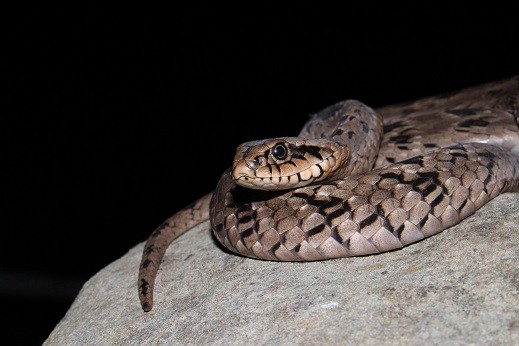
A common species in eastern Africa. Common night adders range from South Africa to as far north as Ethiopia, and Zimbabwe doesn’t escape their wrath. This snake has a false name, as while they’re able to hunt at night, they’re more active during the day. Causus rhombeatus is a heavily toad-eating snake, and hence tends to appear in damper regions of Zimbabwe.
Common night adders don’t have particularly memorable patterns, with grey and black intermingling. Its colours are quite similar to the harmless common egg eater (Dasypeltis scabra). But they can easily be identified by a black V-shaped marking on the head, with the point ending between the eyes. Uncommonly for a viper, this species has round pupils rather than vertical.
Though venomous, aggressive and eager to bite victims, common night adders have no confirmed deaths to their name. The venom is mostly cytotoxic, causing swelling and possibly mild necrosis.
This species only measures 30-60cm. Even the longest of all time was only 93cm (discovered in eastern Zimbabwe). However, this isn’t a license to underestimate them. Rhombic night adders can move surprisingly quickly, advancing 3 feet in one second from their stationary position on a rock. This is the longest and stockiest of the Causus viper genus, with a bulky head and large tail.
| 2 | Common purple glossed snake |
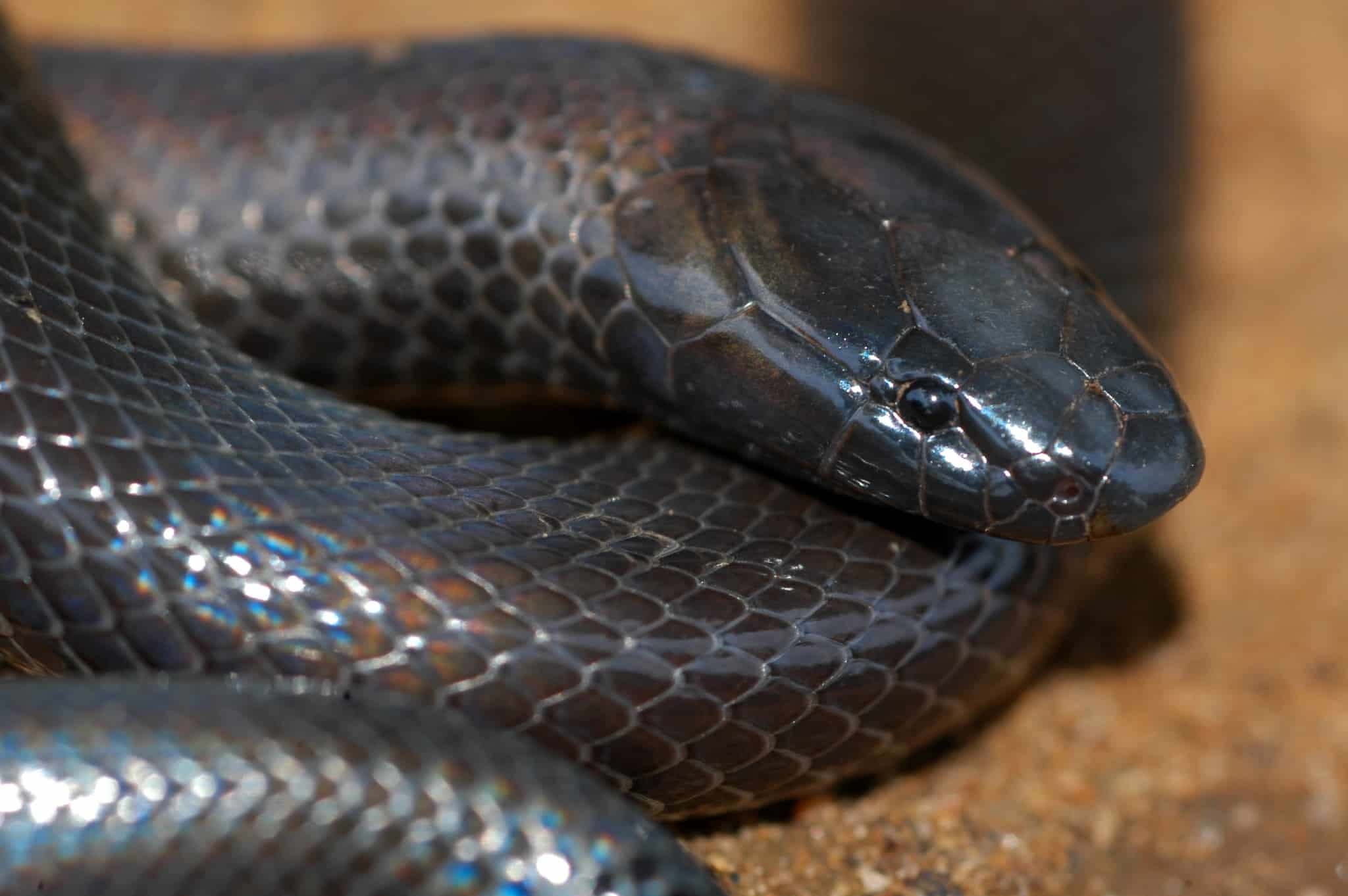
The common purple glossed snake (Amblyodipsas polylepis) is a fossorial burrower which usually only appears after heavy rains, sometimes under leaf litter near farms or a mango tree. This snake isn’t the fastest or most venomous in Zimbabwe, but it might be one of the shiniest. It also has an iridescent sheen, reflecting back the colours of the rainbow, like the sunbeam snake of Thailand.
Purple-glossed snake possess venom, but its properties are barely understood. It’s assumed to be mild, perhaps capable of causing swelling.
This snake measures up to 112cm, and rarely bites or lunges wildly. Instead, purple glossed snakes prefer to entrance their enemies. They hide their head and move their tail, which looks virtually identical, in a rhythmical pattern so that predators get distracted and attack the wrong body part. This isn’t a problem for us, as most humans aren’t hellbent on destroying a snake’s brain, but running far away before the snake can bite them.
Purple glossed snakes mainly prey on another underground family: the worm lizards, legless reptiles which look like snakes themselves. Species confirmed in their diet include Monopeltis luandae, Anchieta’s worm lizard, and Zygaspis violacea.
| 3 | Olive grass snake |
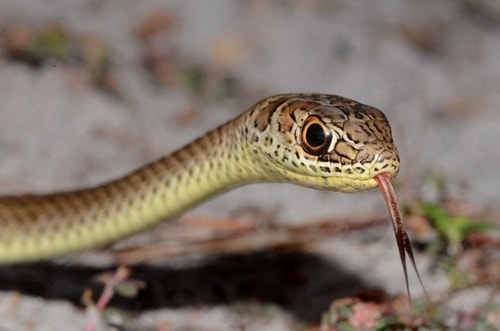
A member of the vast, 33-strong Psammophis genus, which is abundant in central and northern Zimbabwe, through to Kenya. Like the rest, this is a fast-moving snake which is strongly reliant on eyesight rather than smell. Olive grass snakes (Psammophis mossambicus) reach a decent size of up to 1.8 metres, and live in moist grasslands. When not zipping around investigating their surroundings, they rest in termite mounds, small mammal holes, and fallen logs.
This snake may lack venom, but it has one weird skill of note. Like the Montpellier snake of Spain, Psammophis mossambicus is one of a handful of snakes worldwide to rub itself with a mysterious nasal secretion, covering every inch of their scales and giving them a nice shine. The purpose is unknown – there’s apparently no connection to mating, and preventing moisture loss in the harsh sun is one theory.
One of their favourite food sources is Mearns’s pouched mouse, which also likes soft moist grasslands. According to this 2006 study, olive grass snakes are far more common in areas without large African herbivores, including cattle. Their absence allows rodents to increase, giving olive grass snakes a mealtime bonanza.
Unlike the cross-marked grass snake, a distant offshoot, the olive grass snake is nestled in the centre of the Psammophis family tree. Their closest relative is the olive grass racer (Psammophis phillipsi), followed by the short-snouted grass snake (P. brevirostris) and leopard grass snake (P. leopardinus).
| 4 | Eastern bark snake |
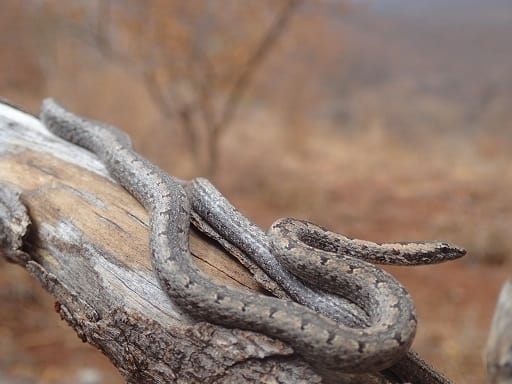
This species is called the eastern bark snake because that’s what it looks like. It looks like God was out of ideas for his next creature and cast a spell on a nearby twig instead.
Eastern bark snakes (Hemirhagerrhis nototaenia) occur in most of Zimbabwe, as well as Mozambique and northeast South Africa. They’re sometimes found lying on branches, but particularly favour cracks in tree stumps where their bark camouflage allows them to completely vanish. This is a slightly venomous snake, which poses little threat to humans, and measures only 50cm at the maximum.
Eastern bark snakes prefer habitats at neither extreme, neither too wet nor too dry. They’re mainly found in dry savannahs, moist savannahs, and lowland forests. Lurking between tree cracks is actually an ambush strategy, where they blend in, wait patiently, and pounce savagely at lizards walking past. These lizards probably think in their last seconds (unless they manage to dodge) that the tree is coming to life and pulling them in.
Eastern twig snakes are confirmed to hunt cape dwarf geckos (Lygodactylus capensis), and sometimes lure them in by waving an orange-tipped tail in a caterpillar motion. In one observation, the curious gecko was edging closer to the tree crack, until the bark snake accidentally moved its head ever so slightly, alerting the gecko and sending it fleeing.
| 5 | Black-headed centipede eater |
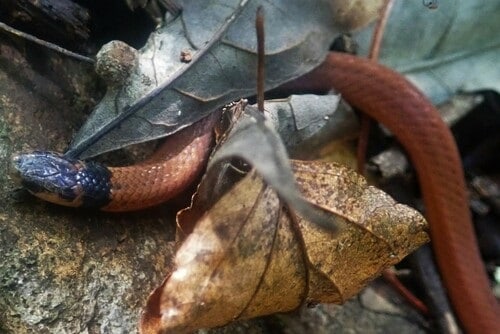
This species is recognisable by its black head contrasting against a uniformly red body. Black-headed centipede eaters (Aparallactus capensis) live in southern Zimbabwe through to South Africa, and make their bases in old termite mounds, where they can plot their next escapade in peace.
After seizing a centipede, they chew on their bodies for prolonged periods to inject a mild venom, ensuring that enough tiny droplets enter its body. Gradually, the centipede becomes paralysed, and the snake can swallow, which is always performed headfirst. Black-headed centipede eaters measure 30cm (max 40cm), and are rarely aggressive towards humans.
For years, centipedes were the only food Aparallactus capensis was ever witnessed eating. Scientists wanted to test this reputation, so they examined 62 old centipede eaters stored in museums. They extracted 21 food items in total, and each one was a centipede, confirming what everyone suspected.
They concluded: “if cape centipede eaters do eat non-centipede prey, they do so very infrequently“. Most prey items belonged to the order Scolopendromorpha, the most aggressive and venomous centipedes of all.
| 6 | Spotted bush snake |
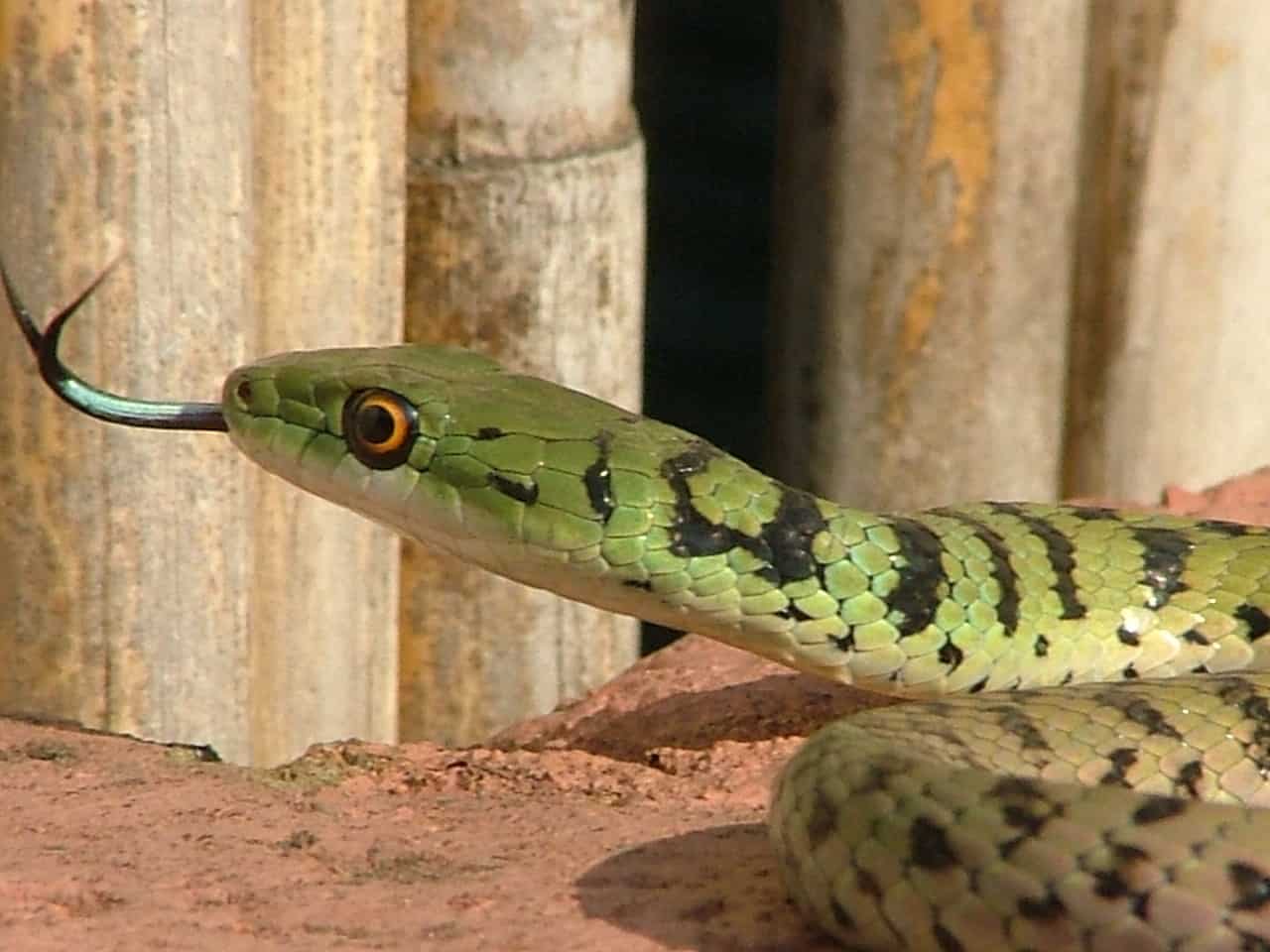
One of Africa’s most widespread snakes. This is a nervous and alert snake with superb climbing abilities. Spotted tree snakes reach a record of 140.5cm, and appear in trees, rafters, and on brick walls alike. They have large eyes, which aren’t just cosmetic, but provide them with excellent vision.
Spotted tree snakes (Philothamnus semivariegatus) aren’t territorial, and many individuals will sometimes gather in the same tree. They’re found across most of Zimbabwe, and indeed 60-70% of sub-Saharan Africa. This species is a juicy green, with round pupils surrounded by an orange iris. Spotted tree snakes look similar to boomslangs or even black mambas, but can be distinguished by multiple black dots on their upper body. These black dots are particularly large as hatchlings, before gradually shrinking in adulthood.
Though constantly photographed in branches, Philothamnus semivariegatus isn’t a true forest snake. They prefer mixed areas with various tree clumps, such as savannahs, or cultivated human areas on the outskirts of forests. Their nemesis in the wild is the rock monitor, an absolute tank of a reptile, which eats them alive, swallowing by the tail.
| 7 | Black file snake |
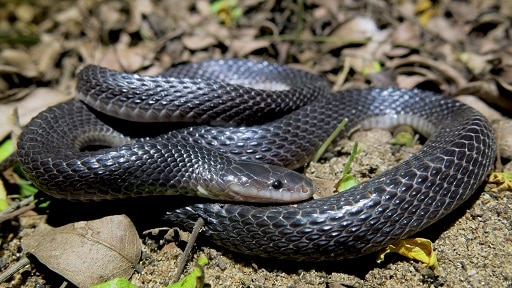
A very difficult snake to identify. There’s several other black, glossy and shiny snakes in the southern African region, including in Zimbabwe. These include the dangerously venomous stiletto snake, and underground dwellers like black thread snakes. Only an expert can distinguish these lookalike serpents, but black file snakes have small white cracks visible between each black scale.
This species (Gracililima nyassae) measures up to 65cm, and is the only member of the Gracililima genus. They travel in strange, jerky movements when nervous, and if picked up, they do virtually nothing, staying still and occasionally raising their heads up.
Black file snakes primarily consume lizards, but occasionally other snakes, including the eastern shovel snout. They live in dry forests, but also the heart of the savannah, with a whole set of iconic African creatures. You could spot one from a Safari vehicle if your eyes were sharp enough, but most people will be distracted and drawn to majestic giraffes or cobras instead. Even then, black file snakes usually stick to the protective line of vegetation, giving them a corridor of shelter. This Zimbabwean snake would rather not be noticed if possible.
| 8 | Snouted night adder |
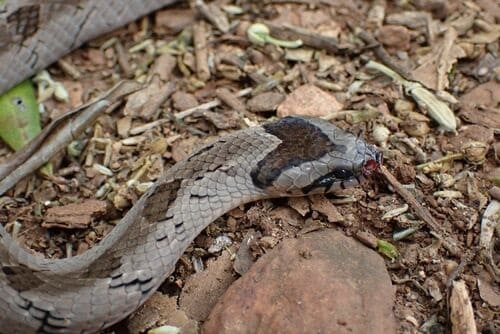
A smaller, slenderer cousin of the rhombic night adder. This species sticks to savannahs both dry and moist, and reaches 1800 metres in altitude. Snouted night adders (Causus defilippii) can be separated by an upturned snout, as the name suggests. While slightly less widespread than their cousin, they’re still found in most of Zimbabwe. Snouted night adders are easy to find as well, as they love to bask in the sun while resting on rock slabs. This is a tiny viper species, as the maximum length ever was just 42cm.
Snouted night adders have a similar venom to spotted night adders. Symptoms include rapidly induced swelling, fever and intense pain. But with a smaller length of 20-35cm, they inject correspondingly less venom, and the effects are milder overall. Most swelling subsides after 2-3 days.
Skills of this snake include hunting during both day and night. Like their cousin, this is a toad lover. Rather than many small toads, snouted night adders prefer to eat one large toad per meal, including the likes of square-marked toads (Bufo regularis). They also feed on frogs such as African puddle frogs (Phrynobatrachus genus) and African striped frogs (Spelaeophryne methneri).
| 9 | East African egg eater |
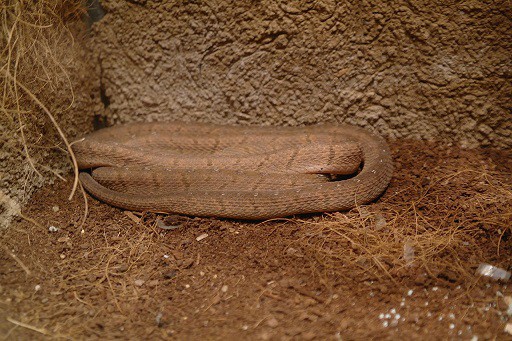
Another member of the Dasypeltis egg-eating genus (which has 18 members). This non-venomous species inhabits the extreme east of South Africa, before continuing northwards through Mozambique, into a sizeable portion of eastern Zimbabwe.
Eastern egg eaters measure up to 90cm, and are incredibly skilled at finding bird eggs. They’re so effective at sussing out their hidden locations that it’s like they’re tracking a beeping homing device. They swallow these eggs whole, and crack the shells open from within using specially modified vertebrae. This egg-shattering spine has been evolved by several completely unrelated snakes worldwide, such as Japanese ratsnakes.
Eastern egg eater snakes (Dasypeltis medici) live in moist savannahs and evergreen forests, top locations for birds to lay their eggs. Yellow-streaked bulbul eggs are one confirmed meal.
Though non-venomous, this species is far from timid. When threatened, east African egg eaters will immediately swivel into an S-shaped coil. This species makes a double warning sound. They not only hiss sharply, but make an odd whistling sound as they inhale air to prepare for that hiss. They already have an expandable throat in place for their diet, and when threatened, they inflate this throat grotesquely to make themselves appear deceptively large.
The more closely a threat (such as a human) approaches, the tighter the coils will become. All this is a ruse though – the eastern egg eater doesn’t even have teeth. They even rub their own scales together sometimes, creating a rasping sound.
| 10 | Striped skaapsteker |
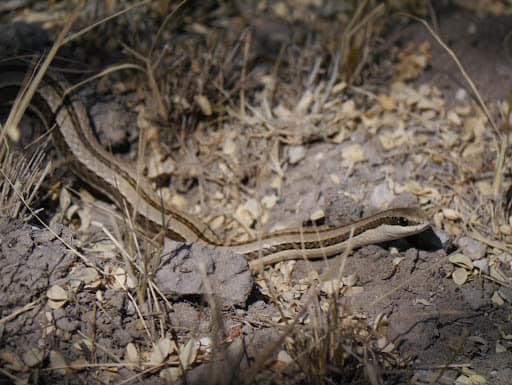
A sleek snake with a long tail, and a maximum length of 93cm. This is a rapid-moving species which doesn’t seem to have an off button. Spotted skaapstekers (Psammophylax tritaeniatus) inhabit virtually all of Zimbabwe, preferring open areas such as savannahs and grasslands as opposed to forests.
This species eat more mammals than other skaapsteker members, and is particularly comfortable in towns and villages. Residents might lift up a pile of rubbish while whistling a tune, only to have a lurking skaapteker dart away beneath their feet.
Striepd skaaptekers are somewhat venomous, and the exact potency is unresearched. Their venom is believed to be mild, but their rhombic skaapsteker cousin can unleash swelling and throbbing pain. Luckily, striped skaapstekers are reluctant to bite anyway. They could easily wield their speed for evil if they wished, but they much prefer to escape at high speeds.
Striped skaaptekers overlap partially with the rhombic skaapsteker in their territory, but are hard to confuse: the striped version has beige-black stripes, while the rhombic skaapsteker is overlaid black dots.
The manic speed of striped skaapstekers almost certainly evolved to dodge predators, such as snake eagles and monitor lizards. Even the fastest snakes are sometimes caught, so they haven’t truly mastered the art of hyperactivity yet. Therefore, there’s still room for snakes to keep accelerating in the millions of years ahead, and the striped skaapsteker might be the one to get faster.
